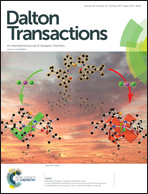Abstract
DFT calculations allied with experimental crystallographic and NMR results elucidate the energetics and the geometrical and 11B nuclear shielding changes in the contrarotational fluxionality of [3,3-(PMe2Ph)2-closo-3,1,2-PtC2B9H11] and confirm the identities of two stable rotational conformers. There is a relatively unhindered contrarotation of the {Pt(PR3)2} and nido-shaped carbons-together {C2B9H11} entities about an axis that contains the platinum atom, with a transition from trihapto to tetrahapto to pentahapto metal-to-cluster interaction as the rotation progresses from 0° to 90°, and a reversal as it progresses in turn through to 180°, and thence through a similar cycle through to 360° for a complete rotation. The overall energy minimum is the trihapto conformation, but there is also an island of stability for the tetrahapto conformation at slightly higher energy, corresponding to experimental observation of these two configurations. The highest-energy pentahapto mode constitutes a transition state, and its energy defines the activation energy for the complete contrarotation, which is matched by activation energies derived from NMR spectroscopy. The shallow minima and small energy differences suggest that ready cluster flexibility will be expected about the minima, again in accord with subtle rotamer angle differences seen in experimental results. Nuclear magnetic shielding criteria suggest significant changes in intracluster bonding as the rotation progresses. The trihapto bonding geometry and the corresponding electronic structure are favoured over quite a substantial arc (some 40°) of the rotation, before rapid changes ensue, and then, after progression through the tetrahapto conformation, the electronics and the bonding geometry then again remain similar within the pentahapto mode for a further 40° or so of the rotational arc about this transition state.
![Graphical abstract: The contrarotational fluxionality of [3,3-(PMe2Ph)2-closo-3,1,2-PtC2B9H11] and related species](/en/Image/Get?imageInfo.ImageType=GA&imageInfo.ImageIdentifier.ManuscriptID=C5DT00984G&imageInfo.ImageIdentifier.Year=2015)
- This article is part of the themed collection: In memory of Professor Kenneth Wade

 Please wait while we load your content...
Please wait while we load your content...